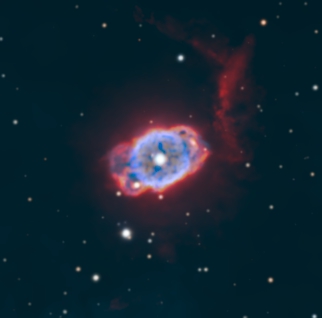 Planetary Nebulae
Planetary Nebulae
NGC 40 (Caldwell 2)

NGC 40 is very small planetary nebula, also called the Bow Tie Nebula.
It is about 3’500 light years from earth and pretty young. The progenitor star died about 4‘500 years ago and blew its outer shells quietly into space. Since then the gas shell has expanded to about 1.25 light years in diameter.
The central star is a bit special. Normally we expect a white dwarf star in the center with an approximate diameter of the earth. In this case however we find a hot star with temperature of 71‘000K and a radius of 0.56 times the radius of the sun. The star seems to consist mainly of Helium and Carbon and is still running on nuclear fusion. Observations with Spitzer and Herschel in the infrared and mid-infrared spectrum suggest the existence of a carbon rich toroidal dust structure around the star. This dusty torus might have been created by the star during a so called Helium flash, which occurred, when the star was going to collapse to a white dwarf. It happened that the star re-ignited nuclear fusion in its core which led to an eruption of carbon rich gas, which then condensed around the star to this toroidal cloud. The star hereafter stabilized again … at least for a while.
There exist several planetary nebulae like this one and they are called born-again PNes.
Borg 90FL
1.08 Flattener
ZWO OAG
ASI 2600MM Pro
ZWO EFW
Baader Ultra-Narrowband 3.5/4nm, RGB Broadband
H: 36x300s
OIII: 12x300s
SII: 32x300s
R: 20x120s
G: 20x120s
B: 20x120s
Total Integration: 8h 40m
Bortle 4-5
PixInsight